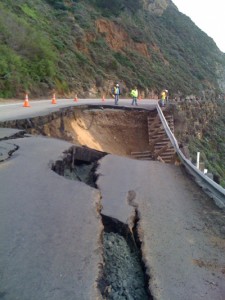
A 40-foot stretch of Highway 1 at Rocky Creek, just north of Big Sur, came crashing down to the sea below after a bout of heavy rain on March 16.
The road suffered some heavy erosion and had been closed for a month for the $2.5 million cleanup project, hampering the travels of residents and tourists of the area.
The road was reopened in mid-June with a controlled traffic light at the affected site.
The lack of sufficient erosion control has greatly affected the California coast highway in its ability to meet the transportation needs of the state, as well as maintain an environmentally safe area.
Erosion, where topsoil is lost due to wind, rain or a combination of the two, is a naturally occurring process that can have serious negative impacts, such as leading to the degradation of ecosystems, increasing air pollution and creating safety hazards and transportation problems.
Particularly in cases where there is little vegetation, intense rainfall and runoff may break down soils and cause them to slide down.
The steep slopes along Highway 1 along the central coast is a prime example of an area that invites landslides and slip-outs due to soil instability and erosion.
“Highway 1 is right by the ocean, so it isn’t the most stable area because you don’t have a strong foundation,” said Susana Cruz of the California Department of Transportation Public Affairs division.
“Landslides are common in the area,” Cruz continued, “but we have had a decrease because we have added retaining walls and other things to try and fasten or secure it to keep things from falling on top or buckling under.”
At the Rocky Creek slip-out, the road was reinforced with a retaining wall, netting, a traffic signal to control traffic and four to five rows of soil nails- long, sturdy strips of metal drilled into the slop at an angle to hold the soil up.
“The retaining wall that was built and how it was configured is all new technology— the rock scaling, helicopter operation, and the netting have been recent developments in the last 10 years,” explained Cruz. “Before that we had months and months of Highway 1 being closed mostly during winter. Now we have ways to secure either the hillside or the ground and stabilize it and make it efficient for people to go through.”
Replanting native vegetation until a strong root system can develop is another helpful aid in preventing excessive erosion along the highway.
Despite new technology and innovative ways to effectively control erosion, travelers and residents of erosion-prone areas must stay informed of any road closures due to erosion-related incidents.
















